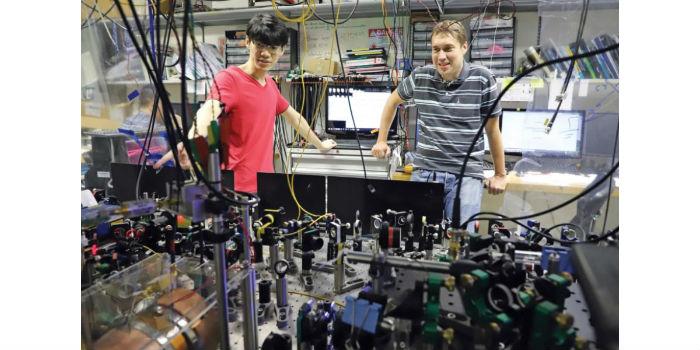 International. Researchers in Singapore have built a refrigerator that is only three atoms in size.
International. Researchers in Singapore have built a refrigerator that is only three atoms in size.
This quantum refrigerator won't keep your drinks cold, but it's good proof that physics works at the smallest scales.
Researchers have built tiny 'heat engines' before, but quantum refrigerators only existed as proposals, until the team at the Centre for Quantum Technologies at the National University of Singapore cooled with their atoms.
The device is an "absorption refrigerator". It works without moving parts, using heat to drive a cooling process. "Our device is the first implementation of the absorption cooling cycle at the nanoscale," says co-author Stefan Nimmrichter.
To create an absorption fridge with only three atoms he took exquisite control. "As an experimental scientist, it's a joy to be able to manipulate individual atoms," says Gleb Maslennikov, the paper's first author.
First, the researchers captured and held three atoms of the element ytterbium in a metal chamber from which they had extracted all the air. They also took an electron out of each atom to leave them with a positive charge.
Charged atoms, called ions, can be held in place with electric fields. Meanwhile, researchers push and hit the ions with lasers to bring them to their lowest energy state of motion. The result is that the ions are suspended almost perfectly motionless, strung on a line.
Then another laser injects some heat, causing the ions to move. Ions interact with each other because of their similar charges. The result is three ripple patterns: crushing and stretching along the line, like a slinky, rocking like a rocker rotating around the central atom, and zigzagging out of line like a jump rope.
The energy in each ripple mode is quantified, with the energy carried by a series of "phonons". By tuning the motion frequencies, the researchers set the conditions for cooling: so a phonon moving from rocker mode to slinky mode will drag a phonon from zig-zag mode with it. The zig-zag mode loses energy and its temperature drops. At its coldest point, it is within 40 microKelvin of absolute zero (-273C), the coldest possible temperature. Each round of ion preparation and phonon count took up to 70 milliseconds, with cooling for around 1 ms. This process was repeated thousands of times.
Studying such small devices is important to see how thermodynamics – our best understanding of heat flows – may need adjustments to reflect more fundamental laws. The principles of thermodynamics are based on the average behaviors of large systems. They don't take quantum effects into account, which is important for scientists developing nanomachines and quantum devices.
To test quantum thermodynamics, the researchers made careful measurements of how phonons propagate through modes over time.
In particular, the researchers tested whether a quantum effect known as 'squeezing' would increase the performance of the quantum refrigerator.
Squeezing means that the equipment more accurately fixed the position of the ions. Due to the quantum uncertainty principle, that increases the fluctuation at the moment. In turn, this increases the average number of phonons in the rocker mode that drives cooling.
To the team's surprise, squeezing didn't help the refrigerator. "If you have a finite amount of energy to expend, it's better to convert it directly into heat than to use it by preparing a squeezed state," says Dzmitry Matsukevich, who led the experimental work.
However, they find that the maximum amount of cooling, which is achieved with a method called 'single shot', exceeds what classical equilibrium thermodynamics predicts. In this approach, the equipment stops the cooling effect by disabling the ripple modes before it reaches its natural endpoint. Cooling exceeds balance.
Physicist Valerio Scarani, another member of the team, is eager to take things further. "The next question is, can you cool what you want with it? So far, we have the fridge engine, but not the box for the beer," he says.
Source: www.sciencedaily.com














